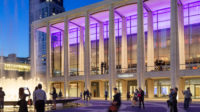Princeton Neuroscience Institute & Peretsman-Scully Hall
Brain Trust: At Princeton University, an architect unites two disciplines with splashes of daylight and easy sociability.




























Architects & Firms
Princeton, New Jersey
Princeton University's new neuroscience and psychology building hunkers calmly, even hermetically, tucked into a slope amid a burgeoning science-research quarter. Across a lawn, the building faces the flamboyant sunshades and monumental gathering space of a genomics laboratory designed by Rafael Vi'oly (Record, November 2003, page 180). The neuroscience entry curves toward an elegant bridge crossing Washington Road, where Hopkins Architects built a nave of ecclesiastic grandeur within a chemistry building that puts the research on display. Such are the architectural gymnastics required to engage the quandaries of scientific investigation: How do researchers collaborate across disciplines while retaining a core professional identity? How do you unite diverse expertise and find a common analytical language to answer critical questions?
The building's massing makes programmatic sense. The four-story horizontal volume accommodates technology-intense neuroscience labs, while the five-story slab is devoted to psychology, where faculty offices and seminar rooms predominate. The two departments meet not in a grand atrium but in a modest lobby spanned by a bridge overhead. Such distinct realms for neuroscience and psychology look ambivalent, but Moneo and senior associate Valeria Mazarakis 'captured extraordinarily well our need to remain two independent entities while having a strong connection,' explains Deborah Prentice, professor of psychology and public affairs. (Hence, the bidisciplinary official name: Princeton Neuroscience Institute and Peretsman-Scully Hall.)
The psychologist's focus on behavior and the neuroscientist's study of the brain have long been united at Princeton, she adds, though the purpose of the building was to consolidate scattered neuroscience facilities (where research teams include physicists, biophysicists, and molecular biologists, among others) in order to retain an idea of 'two overlapping circles' of psychology and neuroscience.
The building begins to reveal its unique approach to mixing disciplines at the lobby. An alcove paneled in shingled oak strips and furnished with glass-topped Moneo-designed tables invites gathering. It's visible from an elegant stair that jogs at landings to make room for conversation as it descends two levels. A massive neuroscience lab core takes up much of the four-story wing's floor plates. Behind closed doors (and red-painted walls) are the labs that demand the greatest control over environmental conditions. Since only limited daylight is allowed, Moneo has ringed the core with a corridor lined by windowed offices for faculty, post-doctoral researchers, and students.
These perimeter offices use the full 10-foot-6-inch ceiling height and reveal the true purpose of the exterior design. Above the vision-glass strips, Moneo hung custom-made ribbed-glass panels (which act as a rainscreen), held beyond the exterior wall on a painted-steel frame. The glass, custom molded and prototyped to achieve precisely the effect Moneo wanted, suffuses the offices with soft, controlled daylight. The light gains dimension by passing through clerestories that separate each office and then flowing into the corridor through the tall lites of custom, full-height sliding doors framed in stainless steel. 'The light and views are important, and beautiful,' Prentice notes. 'People like them.'
Outside the core, in the Human Neuroscience area, Moneo carved out 'patios' deep within the building for a lounge and a classroom, lighting them from above with a clerestory-topped shaft that plunges four floors, sending diffuse light through floor-to-ceiling glass into labs, offices, and meeting rooms along the way. Clerestories also illuminate open stairs that interrupt the long lines of offices outside the lab core, making the trek from floor to floor alluring, and increasing opportunities for casual meetings. Numerous small lounges and shared workspaces (called 'episodes' by Moneo) open along corridors. A Neuro Lounge is an intimate tour de force, offering varied light and views outside to break-takers as it climbs three levels.
It took three years to resolve the labs' diverse demanding technical requirements and then knit them together, according to Mazarakis. That process produced the idea of scattering social spaces throughout the building and enabled the extraordinary attention to detail throughout. (Moneo flew to Princeton some 40 times over the seven-year design and construction period.) 'I would like the spaces to be felt and understood as both student- and faculty-owned,' he explains, 'giving them a certain sense of privacy, even a sense of domesticity, in order to make their work experience more comfortable.'
Researchers have definitely taken ownership, since just about any glass expanse has become a handy writing surface, even though whiteboards are everywhere. (Inevitably, some seek solitude by covering portions of the glass doors and windows.) It is surprising that a building that reads at first as handsomely institutional, even anonymous, gradually reveals an easy informality in the intimate shared spaces made appealing by unexpected splashes of daylight that invite conversation and collaboration.
With so much research taking place in sterile, evenly lit labs cut off from the world, the high stakes'individual consciousness and identity'can seem abstract. Moneo has used primal amenities'sociability and light'to subtly insist on the humanity of the research enterprise.
PeopleClient: Princeton University
Architect
Executive Architect:
Engineers Site / Civil Engineering: Van Note-Harvey
Consultants Curtain wall: Permasteelisa. Cricursa. Glass consultant: Israel Bergman Laboratory programming and planning: Jacobs Consultancy Cost Estimating: Faithful + Gould Acoustic / Vibration / Audio / Visual / Security: Shen Milsom Wilke, Inc. Lighting: Fisher Marantz Stone, Inc, N.Y. Contractor: Barr y Barr, Inc. Builders, N.Y.
Photographer(s): Project cost: 248,000 square feet Size: Withheld Completion date: June 2014 |
ProductsCurtain wall: Permasteelisa Molded exterior glass: Cricursa Fixed auditorium seating: Poltrona Frau |

















